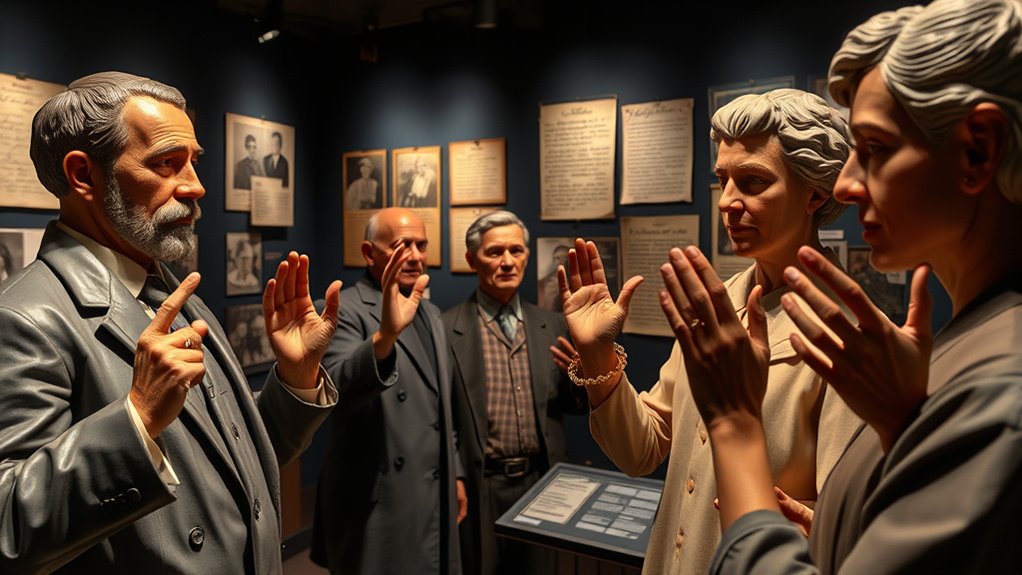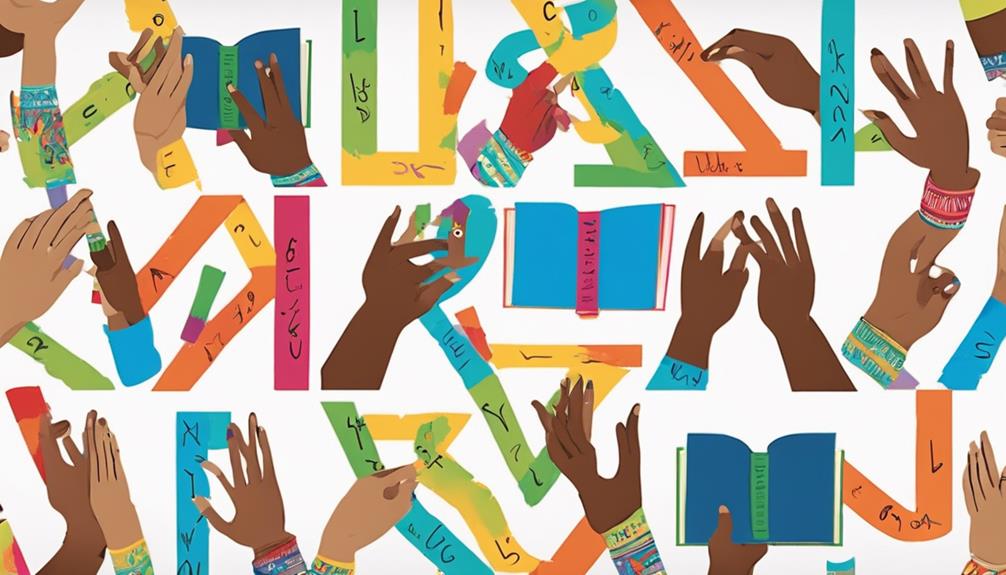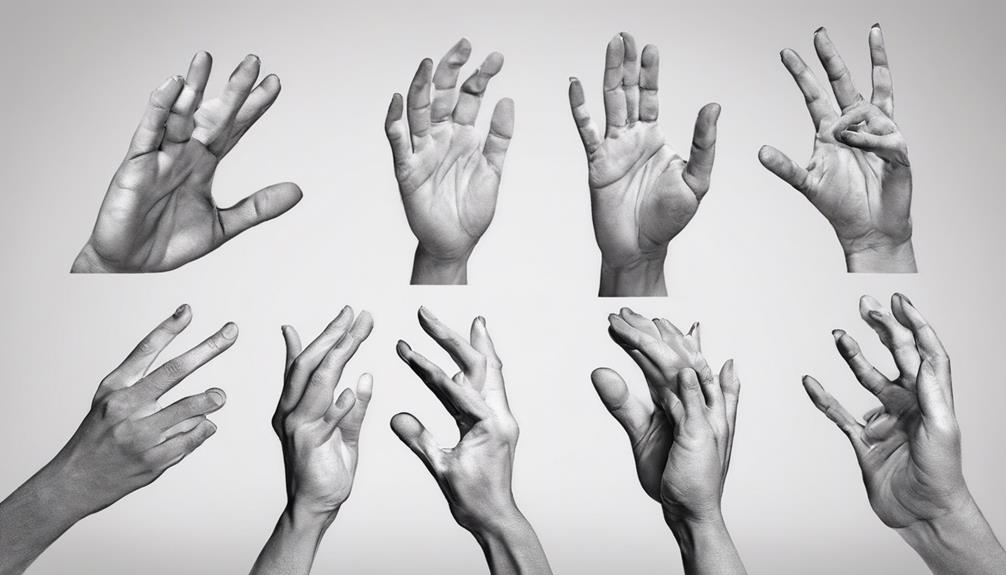Key milestones that shaped modern sign languages include early efforts to develop formal teaching methods, which moved from home signs to structured education in the 18th and 19th centuries. The standardization of signs helped unify diverse gestures into recognized languages, strengthening community identity. Recognitions by institutions, governments, and scholars cemented sign languages’ status as complete languages. If you keep exploring, you’ll uncover how these milestones continue to influence the rich and vibrant deaf cultures today.
Key Takeaways
- Development of home signs and gestures by deaf individuals prior to formal education.
- Establishment of schools for the deaf in the 18th and 19th centuries that formalized sign language teaching.
- Systematic standardization of signs by educators and linguists, transforming regional gestures into recognized languages.
- Sign language fostering cultural identity and community cohesion among deaf populations.
- Recognition of sign languages by educational institutions, governments, and scholars, promoting their global development.

Have you ever wondered how sign language developed over time? The history of sign language is deeply intertwined with efforts to improve deaf education and establish consistent communication methods. In the early days, deaf individuals often relied on home signs or ad hoc gestures, which varied widely from one community to another. Recognizing the need for a more effective way to teach deaf students, educators began to develop formal methods to teach language and literacy, paving the way for more structured approaches. One of the most significant milestones was the emergence of sign language as a recognized medium of instruction in schools for the deaf. These institutions, especially in the 18th and 19th centuries, became essential in shaping deaf education by formalizing teaching methods that used sign language as a primary tool for instruction. This shift helped students learn more effectively and fostered a sense of community among deaf learners.
As deaf education expanded, the importance of language standardization became clear. Before this, there was a wide variety of signs and gestures, which often led to confusion and miscommunication. Educators and linguists began to study existing sign systems systematically, working to create standardized signs that could be widely understood. This effort aimed to improve communication among deaf individuals and ensure that sign language could serve as a complete, expressive language. The standardization process was pivotal because it transformed diverse, often localized gestures into cohesive, recognized sign languages with consistent grammar and vocabulary. These efforts helped establish sign languages as legitimate languages in their own right, rather than mere manual codes or gestures.
The development of standardized sign language also contributed to the recognition of deaf communities and their cultural identity. It provided a foundation for deaf people to communicate across regions and social settings, strengthening their sense of unity and pride. Additionally, cultural identity became a vital aspect of the deaf community’s development, fostering a shared heritage and fostering advocacy for their linguistic rights. Over time, these standardized sign languages gained recognition from educational institutions, governments, and linguistic scholars, further validating their status. Today, efforts continue to refine and promote standardized sign language, making certain that deaf individuals have access to quality education, equal communication rights, and cultural recognition. Understanding this history highlights how deaf education and language standardization played pivotal roles in shaping the vibrant, expressive sign languages used around the world today.
Frequently Asked Questions
How Did Early Societies Perceive Sign Language Development?
You might notice that early societies often had mixed societal attitudes toward sign language development. Some viewed it as a legitimate form of communication, while others held cultural misconceptions, seeing it as inferior or primitive. These perceptions influenced how deaf communities were treated and how sign language was accepted or suppressed. Despite misconceptions, many recognized the value of sign language, laying the groundwork for its eventual recognition and development into modern forms.
Were There Any Significant Regional Differences in Sign Language Evolution?
You might wonder if sign languages evolved uniformly across regions, and the answer is a fascinating yes. Regional dialects and cultural influences create distinct variations, shaping how signs are formed and used. These differences reflect local traditions and histories, making each sign language unique. So, as you explore, you’ll see that regional diversity isn’t just a detail — it’s a crucial part of the rich tapestry of sign language evolution.
What Role Did Deaf Educators Play in Language Standardization?
Deaf educators play a vital role in language standardization by applying deaf pedagogy to develop consistent signs and teaching methods. You help shape the language by advocating for standardized signs, ensuring clear communication within the deaf community. Their efforts foster a shared linguistic identity, making sign language more accessible and unified. Your involvement in deaf pedagogy directly influences how the language evolves, promoting understanding and cultural preservation.
How Did Technological Advances Influence Sign Language Documentation?
You see, technological advances greatly impacted sign language documentation. Visual documentation tools, like video recordings, allowed you to capture signs accurately, preserving their nuances. Digital archives then enabled you to store, access, and share these recordings easily worldwide. This innovation improved consistency, teaching, and research, making sign languages more accessible and standardized over time. As a result, technology transformed how you record and preserve sign language for future generations.
Are There Any Ongoing Efforts to Preserve Historical Sign Language Forms?
You might wonder if preservation initiatives are actively working to save historical sign language forms. Yes, many organizations focus on cultural recognition and document older signs through recordings, archives, and educational programs. These efforts help keep the rich history of sign languages alive, ensuring future generations can learn from and appreciate their linguistic heritage. By supporting these initiatives, you contribute to maintaining the diversity and cultural significance of sign languages worldwide.
Conclusion
As you reflect on these milestones, remember that sign languages are more than just communication tools—they’re symbols of resilience and identity, much like the silent yet powerful stories of those who fought for recognition. Just as the stars guide sailors through darkness, these historical moments illuminate the path toward equality and understanding. Your awareness helps keep their legacy alive, inspiring future generations to continue breaking barriers and celebrating the rich tapestry of human expression.











